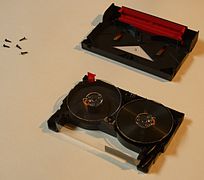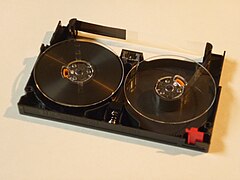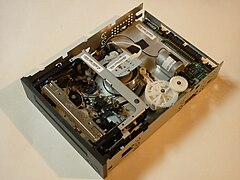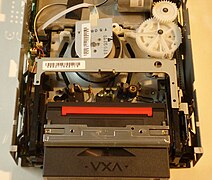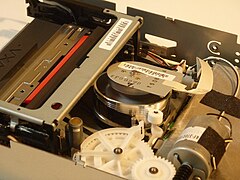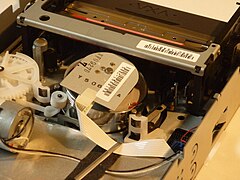VXA
VXA is a data backup format for streamers ( tape drives ) originally developed by Ecrix and bought by Tandberg Data after Ecrix merged with Exabyte Corporation to form Exabyte Data . After the takeover by Tandberg Data on November 20, 2006 , the format was not further developed. VXA has new features compared to related processes such as DLT and AIT . VXA is the first tape format to record data in packets.
function
Exabyte and Ecrix refer to the data format as "Packet Technology". VXA uses helical scan recording , in which data packets are recorded in diagonal strips like the images on a video recorder . What is new about the technology is that the packets start with a unique label, the “Packet ID”, and end with an “ECC” checksum . When a strip is written on the tape, it is immediately read again and a comparison is made to determine whether the recording was error-free. A bad packet is repeatedly written to the tape without stopping and rewinding the tape. For this purpose, the data packets including their ID are kept in a buffer memory. Three checksums are stored in the buffer memory to ensure data integrity. There are two heads in the head drum for this purpose . Both heads can be used when reading. Helical scan recording involves a relatively slow tape speed which allows the tape to be stopped more quickly.
Market area
VXA mainly competes with the DDS and DLT-IV formats . According to the manufacturer, the service life of the media is 20,000 "passes", which corresponds to around 1,000 complete backup processes.
Format overview
| generation | VXA-1 | VXA-2 | VXA-3 | VXA-4 | VXA-5 |
|---|---|---|---|---|---|
| Publication date | 1999 | 2002 | 2005 | TBA | TBA |
| Maximum uncompressed amount of data in GB | 33 | 80 | 160 | 320 | 640 |
| Maximum recording speed in MB / s | 3 | 6th | 12 | 24 | 48 |
| Recording method (modulation / coding) | EFM | PRML | |||
| Magnetic track width | 5.7 µm | ||||
| head | Ferrites | TFMR |
VXA-3
Exabyte launched two lines of VXA-3 technology: VXA-320 in 2005 and VXA-172 in 2006. VXA-172 drives are limited to 86 GB per tape, but can be activated for a fee. Otherwise they are identical. VXA-3 was the first helical track recording system with "MR" heads ready for the market. These are thin film magnetic heads (TFMR) that use the GMR effect .
The storage sizes are physically specified uncompressed. Exabyte assumed a possible compression to 50% and advertised the products with it.
gallery
Cartridge / tape
Mechanism / drive
VXA-1 drive with ATAPI interface
Tape inserted in the drive
See also
ADR , LTO , Mammoth , QIC , DDS / DAT , SLR , Travan
Web links
- ECMA 316 specification of the VXA-1.
- ECMA 222 Specification of the ALDC, the data compression method for VXA-1.
- VXA Alliance
Individual evidence
- ↑ Phone call with Tandberg technical support, speaking to a former Exabyte engineer on July 2, 2010.
- ↑ Exabyte white paper describing VXA Packet Technology ( Memento of the original from August 22, 2010 in the Internet Archive ) Info: The archive link was inserted automatically and has not yet been checked. Please check the original and archive link according to the instructions and then remove this notice.
- ↑ Another VXA Packets explanation
- ^ Exabyte's DDS to VXA migration sales pitch
- ^ Exabyte's DLT to VXA migration sales pitch
- ↑ ECMA-316 2001, pp. 54, 77-83.


